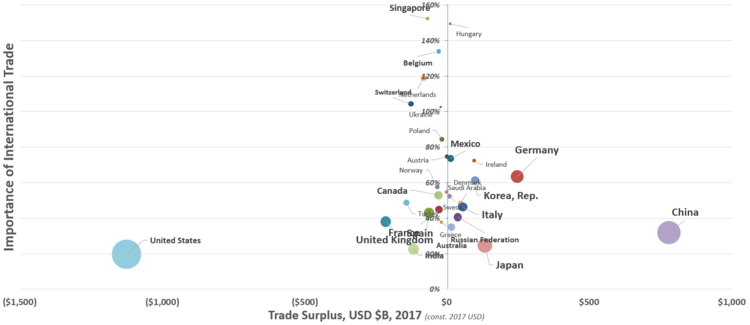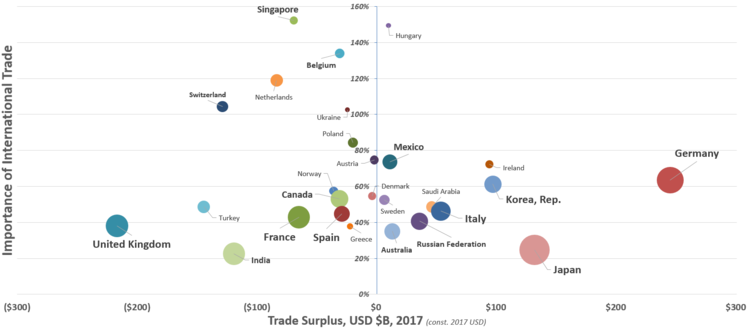How Germany Is Able To Run The World’s Second Largest Export Economy In The Post-Industrial Era
“The Germany Shock” describes European growth & the efficiency-maximizing centralization of European manufacturing activity after the launch of the Single Market and the Euro.Two questions sparked this: 1) why did Europe only adopt the Euro & the Single Market after its Cold War-era existential challenge was over, and 2) how has Germany maintained an export-oriented Industrial Manufacturing Powerhouse while every other developed nation is going post-Industrial?“The Germany Shock” — a summary:
- Germany is a major outlier among high-GDP developed
nations and nobody talks about it
- International trade is a primary source of German
economic prosperity
- Only China runs a larger Surplus from Trade
- Only China runs a larger Surplus from Trade
- No other nation has a customer base anywhere near as
diversified as Germany
- International trade is a primary source of German
economic prosperity
- A China-USA Manufacturing Case Study:
- i) It is possible for a region to straight up lose at
trade
- International competition can reduce employment in
one geographic region without producing an offsetting increase in
employment in that same region
- International competition can reduce employment in
one geographic region without producing an offsetting increase in
employment in that same region
- ii) Manufacturing Network Effects: 3 - 1 = 0
- When the primary economic engine leaves a community, all
the supporting economic activity leaves too, from barbershops
to component suppliers
- When the primary economic engine leaves a community, all
the supporting economic activity leaves too, from barbershops
to component suppliers
- iii) Exchange rates are a Cheat Code for selling
stuff — you might not be willing to cheat, but China is
- When China undervalues its currency, Chinese goods start
looking real cheap
- Foreigners then buy way more Chinese goods than they
otherwise would have
- Foreigners then buy way more Chinese goods than they
otherwise would have
- When China undervalues its currency, Chinese goods start
looking real cheap
- iv) The price of your currency is a reflection of
how desirable your whole nation’s economy is
- The more successful your nation is, the more expensive
it becomes for you to fight the free market and maintain the
fiction of a cheap — undesirable — currency
- China deals with this via intense autocratic market
interventions that are unthinkable in the West or — when tried
in our free markets — lead immediately to failure
- China deals with this via intense autocratic market
interventions that are unthinkable in the West or — when tried
in our free markets — lead immediately to failure
- The more successful your nation is, the more expensive
it becomes for you to fight the free market and maintain the
fiction of a cheap — undesirable — currency
- i) It is possible for a region to straight up lose at
trade
- Case Study Takeaway:
- v) The price of industrial success is eventual failure:
Industrial Exporter nations tend to become stable, regionally
dominant economies…
- …their currencies then become highly sought-after
“Reserve Currencies” — making their products expensive
and undermining the export-driven success that made their
economies so great in the first place
- This spells doom for Germany because of how dependant they
are on selling to other countries
- This spells doom for Germany because of how dependant they
are on selling to other countries
- …their currencies then become highly sought-after
“Reserve Currencies” — making their products expensive
and undermining the export-driven success that made their
economies so great in the first place
- v) The price of industrial success is eventual failure:
Industrial Exporter nations tend to become stable, regionally
dominant economies…
- The German Solution:
- vi) The European Single Market functions to make
German goods maximally attractive to trading partners within
the EU by raising the effective-cost of imported goods
- vii) The German Euro — the currency — then has
its value suppressed via contamination with all the other
(poorer-performing, non-Exporting) European
nations
- This means German goods look cheaper than they otherwise
would to non-EU markets
- This means German goods look cheaper than they otherwise
would to non-EU markets
- vi) The European Single Market functions to make
German goods maximally attractive to trading partners within
the EU by raising the effective-cost of imported goods
- Result:
- viii) The Euro & the Single Market make it possible for
Germany to pursue a strategy of Export-driven Wealth-creation that
would be considered impossible in
any other Western, high-GDP, high-population, high-wage-paying
nation
- European nations that have found a way to support the
German Productivity Engine have built a symbiotic relationship
that strengthens their union
- European nations that have found a way to support the
German Productivity Engine have built a symbiotic relationship
that strengthens their union
Here’s some data most people never see. None of this essay makes sense if you aren’t familiar with it. It’s a bit academic at first, but you’ve got to understand it if you want to get to the entertaining stuff later. Given my focus on the Euro (as a mechanism of exchange and therefore Trade) and the Single Market (obviously about Trade) both being adopted post-German-reunification, the data I want to see is: - viii) The Euro & the Single Market make it possible for
Germany to pursue a strategy of Export-driven Wealth-creation that
would be considered impossible in
any other Western, high-GDP, high-population, high-wage-paying
nation
- Who is making money by Trading with other countries, and exactly how much?
- How important is that Trade to each nation?
- +some way to show the massive GDP differences between nations — some business models only work at a small scaleTake a good look. The tagline here is “Germany is a major outlier among high-GDP developed nations and nobody talks about it.”:

Barely legible, I know, let me zoom in
The USA and China are massive outliers in their own right, so I’m going to shrink the X-axis and exclude them for now so we can actually compare normal nations:

Click to embiggen — The area of each bubble is based on each country’s GDP. See Notes [0] and
[1] for data sourcing — I made zero adjustments, these are all World Trade Organization numbers
The X-axis here represents “money a country makes by Trading with other countries”. Countries to the left spend more money buying foreign products (imports > exports), and countries to the right make more money selling to foreign nations (exports > imports). The X-axis therefore shows how profitable International Trade is to a country....
....MUCH MORE
HT: Rory Sutherland